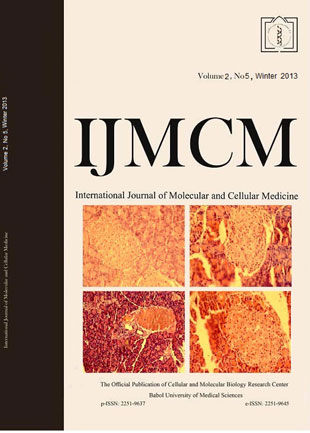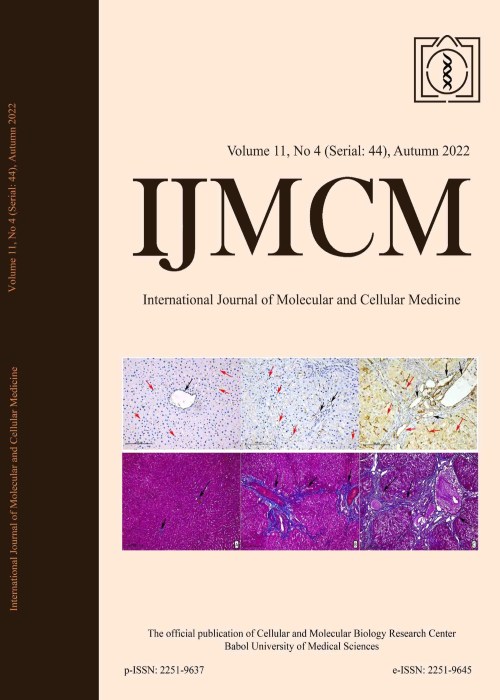فهرست مطالب

International Journal of Molecular and Cellular Medicine
Volume:2 Issue: 5, Winter 2013
- تاریخ انتشار: 1392/02/09
- تعداد عناوین: 8
-
-
Pages 229-236Implantation failure is the most frequent cause of pregnancy loss in couples who try to conceive, either in a natural way or using assisted reproductive techniques (ART). Identify the precise mechanisms of implantation failure can lead to identify couples at risk and also providing appropriate therapeutic options to affected couples. Despite the high prevalence of this disorder, a few causing factors are demonstrated so far. Recent studies indicate that genetic factors play an important role in the occurrence of recurrent implantation failure. Although some of these factors, such as numerical chromosomal aneuploidy are known to be causative factors, there are some other factors that solely increase susceptibility to this event. In the present review we try to list the genetic polymorphisms that are known as susceptibility factors in implantation failure.Keywords: gene, polymorphism, implantation failure
-
Pages 237-241Cholera is an infection of the small intestines caused by the bacterium V. cholerae. It is a major cause of health threat and also a major cause of death worldwide and especially in developing countries. The major virulence factor produced by V. cholerae during infection is the cholera toxin. Total mRNA extraction and reverse transcription was performed for making ctxAB cDNA. Relative Real-Time PCR analysis showed unequal enterotoxin production in V. cholerae strains. The results showed that, classical strain produces cholera toxin more than El Tor strain.Keywords: Vibrio cholerae, RT, qPCR, ctxAB expression
-
Pages 242-248Background And AimJaundice is a common disorder in neonates and one of the provable causes of glucose-6-phosphate dehydrogenase (G6PD) deficiency, some mutation types of which may be associated with severe neonatal icter. In this line, the present study has been conducted to compare G6PD mutations in incteric and non icteric neonates.Materials And MethodsThis case-control study was implemented in the NICU and Newborn Ward of Amirkola Children Hospital in 2007-2008. Available sampling approach was used and 50 icteric as well as 50 non-icteric newborns, both with G6PD deficiency, were selected as the case and the control group respectively. Two milliliters of peripheral blood were collected in EDTA-containing tubes after parental consent and G6PD deficiency was diagnosed using FST (Fluorescent Spot Test) method. All samples were first evaluated in terms of Mediterranean mutation and the negative cases of this mutation were then examined for Chatham mutation; all remaining samples were finally tested for Cosenza mutation. After the completion of the above steps, G6PD mutations were compared in the two groups and P-value less than 0.05 was considered significant.ResultsIn icteric group, 76% were male and 24% were female and in non-icteric group, 70% were male and 30% were female. The mean weight of neonates was 3.2 ± 0.4 kg and 2.8 ± 0.8 kg in icteric and non-icteric groups respectively (p<0.05). In non-icteric group, 54% Mediterranean, 18% Chatham, and 28% Cosenza negative were observed and in icteric group, 56% Mediterranean, 32% Chatham, and 12% Cosenza negative were found; the distribution of Mediterranean and Chatham mutations was not significant between the two groups (p>0.05), however, the distribution of rare mutations (Cosenza negative) was significantly different between icteric and non-icteric groups with enzyme deficiency (p<0.05). The mean bilirubin level was not statistically different in Mediterranean (18.5 ± 2.9), Chatham (18.8 ± 2.1) and Cosenza negative (20 ± 4.3) mutations (p> 0.05). Newborns with Chatham mutation have been less in need of exchange transfusions (p <0.05).ConclusionsFindings of the present study showed that there was no significant relationship between prevalent mutations of G6PD gene and the incidence of icter in Mediterranean and Chatham mutations; Mediterranean mutation was the most common mutation in the mentioned gene in icteric and non-icteric neonates in our region, while Cosenza mutation was more frequent in non-icteric group, indicating that rare mutations of G6PD gene may less likely lead to neonatal icter. Furthermore, the need for exchange transfusion is less in icteric neonates with Chatham mutation which is indicative of milder clinical phenotype in this type of mutation.Keywords: Icter, G6PD deficiency, Mediterranean mutation
-
Pages 249-254Preliminary studies revealed that Urtica dioica has been known as a plant that decrease blood glucose. Despite the importance of this plant in herbal medicine, relatively little research has been down on effects of this plant on islets yet. The objective of the current study was to evaluate the effect of dried urtica dioica leaf alcoholic and aqueous extracts on the number and the diameter of the islets and histological parameters in streptozocin-induced diabetic rats. Six rats were used in each group. Group I: Normal rats were administered saline daily for 8 weeks. Group II: Diabetic rats were administered streptozotocin, 50 mg/kg of body weight; Group III: Diabetic rats were administered dried Urtica Dioica leaf aqueous extracts for 8 weeks; Group IV: Diabetic rats were administered dried Urtica Dioica leaf alcoholic extracts for 8 weeks. The animals, groups of diabetic and normal, were sacrificed by ether anaesthesia. Whole pancreas was dissected. The tissue samples were formalin fixed and paraffin embedded for microscopic examination. Histologic examination and grading were carried out on hematoxylin-eosin stained sections. The effects of administration of dried Urtica Dioica leaf alcoholic and aqueous extracts to diabetic rats were determined by histopathologic examination. The pancreas from control rats showed normal pancreatic islets histoarchitecture. Our results also, indicate that the pancreas from diabetic rats show injury of pancreas tissue while the pancreas from diabetic rats treated with dried Urtica Dioica leaf alcoholic and aqueous extracts show slight to moderate rearrangement of islets. According to our findings, dried urtica dioica leaf alcoholic and aqueous extracts can cause a suitable repair of pancreatic tissue in streptozocin-induced diabetic experimental model.Keywords: Diabetes, pancreas, urtica dioica, rat, alcoholic, aqueous extract
-
Pages 255-261Various cell proliferation markers are used as diagnostic and prognostic tools in oral lesions. Simultaneous evaluation of these markers can increase the precision of estimation of the proliferative status of different tissues. In this study we investigated the expression of PCNA and Ki-67 as markers of cell proliferation in 15 paraffin embedded samples of each dental follicle, dentigerous cyst, unicystic ameloblastoma and ameloblastoma belonging to a total of 30 male and 30 female paients using immunohistochemistry method. Expression levels based on the intensity and the percentage of stained cells was separately analyzed for each marker with chi-square test, the results of which were significant for the two markers (P<0.05). The correlation coefficient between the two markers was found to be 0.88. A significant difference in the expression of Ki-67 and PCNA was observed in the four types of studied lesions.Keywords: PCNA, Ki, 67, immunohistochemistry, dental follicle, dentigerous cyst, ameloblastoma
-
Pages 262-268Oral lichen planus is a chronic inflammatory immune-mediated disease. ICAM-1 and VCAM-1 are vascular adhesion molecules that their receptors are located on endothelial cells and leukocytes. The aim of this study is the immunohistochemical evaluation of VCAM1 and ICAM1 in oral lichen planus and to compare these two markers with normal mucosa for evaluation of angiogenesis. This descriptive-analytical study was performed on 70 paraffined blocks of oral lichen planus and 30 normal mucosa samples taken from around the lesions. Samples were stained with H & E and then with Immunohistochemistry using monoclonal mouse anti human VCAM1 (CD106), & monoclonal mouse anti human ICAM1(CD54) for confirmation of diagnosis. Slides were evaluated under light microscope and VCAM1 and ICAM1 positive cells (endothelial cells and leukocytes) were counted. Data were analyzed with Mann-Whitney test, Wilcoxon and Chi-Square and p<0.001 was declared significant. VCAM1 and ICAM1 expression significantly increased compared to normal mucosa in oral lichen planus according to the percentage of stained cells (p=0.000& p=0.000, Mann-Whitney test). Thirty cases of oral normal mucosa associated with lichen planus showed that the VCAM1 has increased significantly in comparison to normal mucosa (p<0.001). Also, ICAM1 expression between lichen planus and normal mucosa, showed a significantly difference (p<0.001). A significant difference between VCAM1 and ICAM1 expression and type of lichen planus was not observed (p>0.05). Regarding the results, it seems that high expression of VCAM1 and ICAM1 is related to oral lichen planus.Keywords: oral lichen planus, angiogenesis, VCAM1, ICAM1
-
Pages 269-273Hearing loss (HL) is the most frequent sensory defect affecting 1 in 1000 neonates. This can occur due to genetic or environmental causes or both. The genetic causes are very heterogenous and over 100 loci have been identified to cause autosomal recessive non - syndromic hearing loss (ARNSHL). The aim of this study was to determine the contribution of the LRTOMT gene mutations in causing ARNSHL. One hundred fifty seven pupils affected with ARNSHL from Azarbaijan Sharghi, Kordestan, Gilan and Golestan provinces, north and west of Iran, were ascertained. In this descriptive - laboratory study, the presence of LRTOMT mutations were initially checked using PCR – Single - strand conformation polymorphism (SSCP) and heteroduplex analysis (HA) strategy. Samples with shifted bands on the gel were confirmed by DNA sequencing method. The PCR-SSCP/HA and the subsequent direct DNA sequencing showed no mutation in the population studied. We conclude that LRTOMT mutations have no role in causing sporadic deafness in the studied population. Further studies on other populations and samples could clarify the exact role of LRTOMT mutations.Keywords: syndromic sporadic hearing loss, DFNB63, LRTOMT gene, PCR, SSCP, heteroduplex, Iran
-
Pages 274-277BackgroundAntibiotic resistance makes antimicrobial peptides (AMPs) agents an alternative for treatment of pathogenic diseases. They are isolated from various animals invertebrates, vertebrates and plants. The present study shows the electrophoretic pattern of protein and peptides from Vicia Faba seed and reports our first attempt to study the antibacterial activity of Vicia faba seed extract.Methods100g grounded seed was extracted in extraction buffer(10 mM Na2HPO4, 15 mM NaH2PO4, 100mM KCl, 2 mM EDTA, 2mM Thiurea 1.5% PVPP). Following a 70% ammonium sulfate precipitation was carried out. The pellet was dialyses and resuspended in 50mM ammonium acetate, then used for gel filtration chromatography (Sephadex G75). The crude extract electrophoresis was carried out on 12% SDS- PAGE gel. Antibacterial activity on E.Coli and B. Subtilis from hospital infection was tested and evaluated by measuring the inhibition zone diameter observation.ResultsThe SDS- PAGE gel electrophoresis shows the crude extract contains many proteins with different spectrum molecular weight of proteins and peptides. The inhibition zone doesn’t observe in antibacterial properties tests. So, our experiments don’t show any antibacterial activity on E.Coli and B. Subtilis from hospital infection.ConclusionIn our study, bacteria from hospital infection resists to Vicia faba seed extract. Some other AMPs haven’t also shown any antimicrobial properties on clinical trail. To show the antibacterial activity of the crude Vicia faba seed extract, it should be tested on some standard bacteria.Keywords: Antibacterial peptide, antimicrobial peptide, plant, Vicia faba


